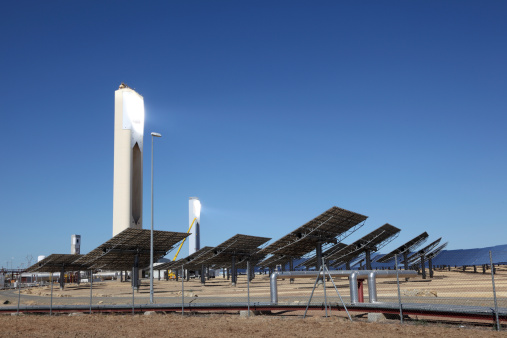The New Mexico Public Regulation Commission (NMPRC) approved a plan to replace all the electric power generated by the San Juan Generating Station (SJGS) with electricity generated by solar panels and batteries.
The SJGS is an 847 Megawatt (MW) coal-fueled power plant located in New Mexico that has been providing power to the utilities in the multi-state region since the 1970s, co-owned by several companies and municipalities, including PNM Resources; Tucson Electric Power; the City of Farmington, New Mexico; Los Alamos County, NM; and Utah Associated Municipal Power Systems.
PNM Resources, New Mexico’s largest utility and majority owner of the SJGS, announced plans to close the power plant in 2022, opting to take advantage of generous federal and state subsidies given to new renewable power facilities, and tax advantages and fees granted to utilities for new power plant construction.
Despite NMPRC’s decision, SJWS may continue operating under new ownership and with new technologies beyond 2022. Enchant Energy, a carbon capture-and-storage company and current co-owner the city of Farmington, is in talks with SJGS’ other co-owners to purchase and retrofit the plant with carbon capture technology to keep it operating, even though it would no longer provide electricity to PNM’s customers.
Regulators Reject Natural Gas
To ensure the most reliable replacement for SJGS at the lowest cost to ratepayers, PNM recommended a “hybrid” replacement scenario, in which the utility would add 280 MW of gas-fueled electricity, along with a mix of solar, wind, and battery storage, to replace its 497 MW share of electric power from the power plant.
NMPRC rejected PNM’s preferred plan, instead voting on July 29 to impose an alternative option on the utility and ratepayers requiring 650 MW of new solar-generated power, to be backed up by 300 MW of battery storage.
NMPRC said its choice of the all-renewable option was forced on it by the terms of the New Mexico’s Energy Transition Act (ETA) that became law in 2019, which requires utilities in the state to ensure 50 percent of the electric power they deliver comes from renewable energy sources by 2030, that 80 percent of the electricity comes from renewable sources by 2040, and that 100 percent from carbon dioxide emissions-free generating sources by 2045.
In an interview with Utility Drive, NMPRC Commissioner Cynthia Hall said the commission’s decision to choose the all-renewables plan was “basically unavoidable,” being the only replacement option that would fully satisfy ETA’s requirement to transition to electricity in the long run that emits no carbon dioxide during generation by 2045.
In an email sent by Raymond Sandoval, a spokesperson for PNM, to Utility Drive, Sandoval said the company would find a way to comply with the NMPRC’s plan while still keeping its customers’ power on.
“[PNM is] reviewing all options to implement this decision while maintaining reliable power for our more than 530,000 customers,” Sandoval said in an email.
‘Higher Energy Costs Guaranteed’
Government data shows operating existing coal, natural gas, hydroelectric, and nuclear plants provides a cheaper source of electricity than replacing them with new plants or renewable power sources like wind or solar, says Tim Benson, a policy analyst with The Heartland Institute. The data also show battery backup power is the highest-cost source of electric power. Because of these facts, laws mandating utilities use renewable energy sources are guaranteed to increase energy costs, Benson says.
“It appears the Public Regulatory Commission’s hands are tied by the Energy Transitions Act, and that is the problem with such legislation,” Benson said. “The higher energy costs guaranteed by a switch from fossil fuels to higher-cost ‘renewable’ electricity sources, such as wind or solar, lead to slower economic growth.
“Studies are pretty clear on this,” Benson said. “One from the University of Chicago last year shows renewable energy mandates have cost the residents of the states imposing them an extra $125 billion.”
New Mexico’s ETC could hamper its recovery from the economic shutdown in response to COVID-19, Benson says.
“Affordable energy is the key to productivity growth and the production of virtually all goods and services,” Benson said. “Enacting this plan is going to make everything more expensive for working families in New Mexico, raise costs for businesses, and have an insignificant effect on global carbon dioxide emissions.
“While the country is still dealing with the after effects of the COVID-19 pandemic, taking any action that would increase energy costs for people already struggling financially in a economically uncertain time seems, at best, very short-sighted, at worst, cruel,” Benson said.
Sterling Burnett, Ph.D. (hsburnett@heartland.org) is the managing editor of Environment & Climate News.
Internet Info
Thomas F. Stacy and George S. Taylor, “The Levelized Cost of Electricity from Existing Generation Resources,” Institute for Energy Research, June 3, 2019: https://www.heartland.org/_template-assets/documents/publications/IER%20levelized%20cost%20of%20electricity%20existing%20sources%202019.pdf
Tim Benson, “Research & Commentary: Renewables Portfolio Standard Expansion Would Disproportionally Harm Low-Income New Mexicans,” The Heartland Institute, February 15, 2019: https://www.heartland.org/publications-resources/publications/research–commentary-renewables-portfolio-standard-expansion-would-disproportionally-harm-low-income-new-mexicans



























[…] New Mexico Utility Regulators Approve Replacing Coal Power with Solar […]